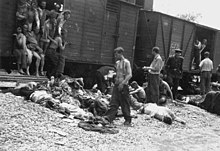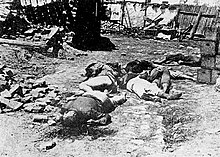The Holocaust in Romania

The Holocaust in Romania was the development of the Holocaust in the Kingdom of Romania. Between 380,000 and 400,000 Jews died in Romanian-controlled areas, including Bessarabia, Bukovina and Transnistria.[1] Romania ranks first among Holocaust perpetrator countries other than Nazi Germany.[2][3][4]
Background
[edit]In the first decades of the 20th century, antisemitic views took the form of separation of Jews from European archetype[clarification needed] in publications and writings of prominent Romanian figures such as A.C. Cuza, Nichifor Crainic, Nicolae Iorga, Nicolae Paulescu and Ion Găvănescu.[5] The main political organisation that took these ideas and built them into an open attack on the Jewish community in Romania was the Iron Guard. Formerly a small political group under the name of Guard of National Conscience, the movement gained in its ranks in 1920 Corneliu Zelea Codreanu. Divisions and disagreements within the group and between members led Corneliu and others to leave and form the Legion of Archangel Michael in 1927, and then in 1930 the Iron Guard was created as an organisation to unite it with other nationalist groups. Despite renaming the organisation several times, in the media and public eyes the image and name of Legionaries and Iron Guard stuck for the anti-communist, antisemitic, fascist movement.[6]
Pre-war government policies and legislation
[edit]
In Romania, antisemitic legislation was not an attempt to placate the Germans, but rather entirely home-grown, preceding German hegemony and Nazi Germany itself. The ascendance of Germany enabled Romania to disregard the minorities treaties that were imposed upon the country after the First World War. Antisemitic legislation in Romania was usually aimed at exploiting Jews rather than humiliating them as in Germany.[7]
At the end of 1937, the government of Octavian Goga came to power, Romania thus becoming the second overtly antisemitic state in Europe.[8][9] Romania was the second country in Europe after Germany to enact antisemitic legislation, and the only one besides Germany to do so before the 1938 Anschluss.[10][11] Romania was the only country other than Germany itself which "implemented all the steps of the destruction process, from definitions to killings."[12][13]
Anti-Jewish violence and deportations
[edit]

The Romanian Holocaust was outside the control of the Nazis. Its beginning did not require Nazi intervention, Romania being the only ally of the Third Reich that carried out its genocidal campaign without the intervention of Heinrich Himmler's SS.[14] The "wholesale slaughter of Jews" in Romanian-occupied Soviet territories was "a genocide operationally separate from the Nazi Final Solution". It was by far the greatest extermination of Jews by non-German forces.[15] Romania also rejected Nazi designs on its Jews, ultimately declining to deport Romanian Jews to the Belzec concentration camp.[16] Romania even took the lead in the Holocaust for the first weeks of Operation Barbarossa. This was acknowledged by Adolf Hitler on 19 August 1941: "As far as the Jewish Question is concerned, it can now be stated with certainty that a man like Antonescu is pursuing much more radical policies in this area than we have so far." The regime of Ion Antonescu had been killing Jewish women and children, clearing entire Jewish communities, while Nazi Germany was still massacring only Jewish men.[17]
See also
[edit]- Antisemitism in Romania
- Deportations of Romani people to Transnistria
- Post-World War II Romanian war crime trials
References
[edit]- ^ "Murder of the Jews of Romania". www.yadvashem.org. Archived from the original on 6 February 2022. Retrieved 23 February 2022.
- ^ Midlarsky, Manus I. (17 March 2011). Origins of Political Extremism: Mass Violence in the Twentieth Century and Beyond. Cambridge University Press. ISBN 9781139500777 – via Google Books.
- ^ Valeria Chelaru: Tradition, Nationalism and Holocaust Memory: Reassessing Antisemitism in Post-Communist Romania, page 73
- ^ Roland Clark: New models, new questions: historiographical approaches to the Romanian Holocaust, page 304
- ^ Lucian Tudor: The Romanian Iron Guard: Its Origins, History, and Legacy, page 69
- ^ Lucian Tudor: The Romanian Iron Guard: Its Origins, History, and Legacy, pages 70-79
- ^ Hollander, Ethan J. (25 October 2016). Hegemony and the Holocaust: State Power and Jewish Survival in Occupied Europe. Springer. ISBN 9783319398020 – via Google Books.
- ^ Brustein, William (13 October 2003). Roots of Hate: Anti-Semitism in Europe Before the Holocaust. Cambridge University Press. ISBN 9780521774789 – via Google Books.
- ^ Ioanid, Radu (20 April 2022). The Holocaust in Romania: The Destruction of Jews and Roma Under the Antonescu Regime, 1940–1944. Rowman & Littlefield. ISBN 9781538138090 – via Google Books.
- ^ Weinbaum, Laurence (31 January 2004). "Where Memory is a Curse and Amnesia a Blessing: A Journey Through Romania's Holocaust Narrative". Institute of the World Jewish Congress – via Google Books.
- ^ Kar dy, Viktor (1 January 2004). The Jews of Europe in the Modern Era: A Socio-historical Outline. Central European University Press. ISBN 9789639241527 – via Google Books.
- ^ Sorkin, David; Sorkin, Professor David (Professor) (14 September 2021). Jewish Emancipation: A History Across Five Centuries. Princeton University Press. ISBN 9780691205250 – via Google Books.
- ^ Stenberg, Peter (31 January 1991). Journey to Oblivion: The End of the East European Yiddish and German Worlds in the Mirror of Literature. University of Toronto Press. ISBN 9780802058614 – via Google Books.
- ^ Henry Eaton, Wayne State University Press, May 2013, The Origins and Onset of the Romanian Holocaust
- ^ Stanley G. Payne, University of Wisconsin Pres, Jan 1, 1996, A History of Fascism, 1914–1945, p. 396
- ^ Ion Popa, Indiana University Press, Sep 11, 2017, The Romanian Orthodox Church and the Holocaust, p. 30
- ^ Maksim Goldenshteyn, University of Oklahoma Press, Jan 20, 2022, So They Remember: A Jewish Family’s Story of Surviving the Holocaust in Soviet Ukraine, p. 8
